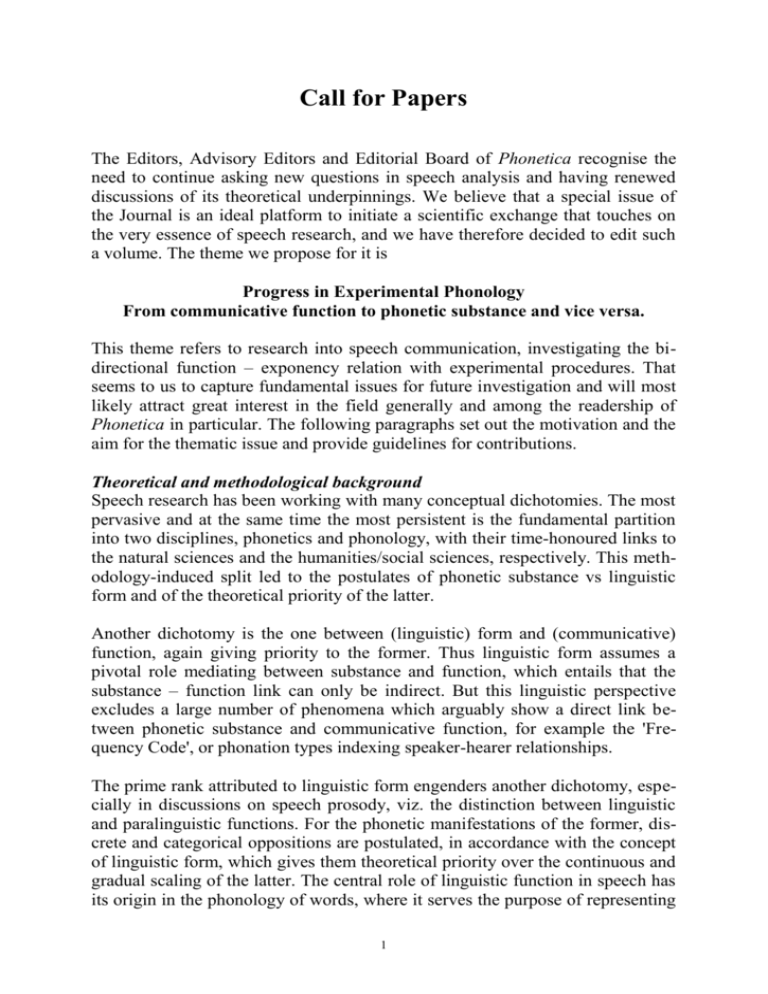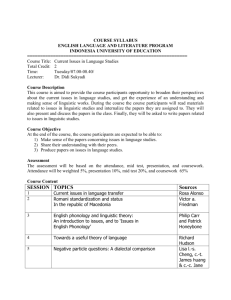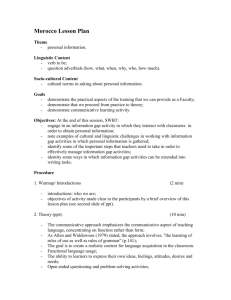Progress in Experimental Phonology
advertisement

Call for Papers The Editors, Advisory Editors and Editorial Board of Phonetica recognise the need to continue asking new questions in speech analysis and having renewed discussions of its theoretical underpinnings. We believe that a special issue of the Journal is an ideal platform to initiate a scientific exchange that touches on the very essence of speech research, and we have therefore decided to edit such a volume. The theme we propose for it is Progress in Experimental Phonology From communicative function to phonetic substance and vice versa. This theme refers to research into speech communication, investigating the bidirectional function – exponency relation with experimental procedures. That seems to us to capture fundamental issues for future investigation and will most likely attract great interest in the field generally and among the readership of Phonetica in particular. The following paragraphs set out the motivation and the aim for the thematic issue and provide guidelines for contributions. Theoretical and methodological background Speech research has been working with many conceptual dichotomies. The most pervasive and at the same time the most persistent is the fundamental partition into two disciplines, phonetics and phonology, with their time-honoured links to the natural sciences and the humanities/social sciences, respectively. This methodology-induced split led to the postulates of phonetic substance vs linguistic form and of the theoretical priority of the latter. Another dichotomy is the one between (linguistic) form and (communicative) function, again giving priority to the former. Thus linguistic form assumes a pivotal role mediating between substance and function, which entails that the substance – function link can only be indirect. But this linguistic perspective excludes a large number of phenomena which arguably show a direct link between phonetic substance and communicative function, for example the 'Frequency Code', or phonation types indexing speaker-hearer relationships. The prime rank attributed to linguistic form engenders another dichotomy, especially in discussions on speech prosody, viz. the distinction between linguistic and paralinguistic functions. For the phonetic manifestations of the former, discrete and categorical oppositions are postulated, in accordance with the concept of linguistic form, which gives them theoretical priority over the continuous and gradual scaling of the latter. The central role of linguistic function in speech has its origin in the phonology of words, where it serves the purpose of representing 1 lexical differentiation. But at the level of the utterance, paralinguistic functions need to be put in focus because they are central to communication and of great interest to the social sciences. Then there is a traditional dichotomy that cuts across the ones of substance, form and function, i.e. the partition of speech into segmentals (vocal tract and excitation mode) and suprasegmentals (fundamental frequency, intensity, duration), more particularly into phonemes and prosodies, where the former have gained theoretical priority and have determined the way the latter are investigated. This division plays down the facts (1) that the separation of segmentals and suprasegmentals may be drawn differently, giving prosodic status to articulatory properties, and (2) that the two domains interact, with prosodies determining the manifestation of segments, and segmental manifestations signalling prosodic categories and boundaries. In addition, the theoretical significance of phonemic segments as autonomous speech recognition units has been questioned. Finally the scientific community has become accustomed to attributing investigations either to the field of production or of perception. This dichotomy loses sight of the central role of the listener in speech communication. On the one hand, the speaker produces and adjusts speech in varying contexts of situation for the listener, and, on the other hand, not everything that is in the acoustic signal, due to articulatory constraints, is relevant in the decoding by the listener, nor, as a result of auditory transformation, is every acoustic property of the signal perceived unaltered by the listener. So analyses of speech production, in corpus as well as in experimental data, need to consider the perceptual relevance of articulatory and acoustic patterns. All these dichotomies have had a great heuristic value in speech analysis, but there comes a point where further insight seems likely to be limited if we maintain them, i.e. the divisions need to be broken down and replaced by new conceptualizations. Laboratory Phonology, as represented by the biennial conference and proceedings series, has been working quite extensively at bridging the gap between phonetics and phonology. While we believe that this approach has substantially advanced our understanding of a large variety of phenomena, we also believe that important aspects of speech, though not overlooked by laboratory phonologists, need far more attention than they have received. Especially, when the focus shifts from words of scripted speech to unscripted, spontaneous utterances, the whole spectrum of communicative functions, over and above linguistic form, becomes relevant, and requires new methods, for example further development of what has already been initiated in conversation analysis. Moreover, the dichotomies of linguistic vs paralinguistic phenomena and functions, and of suprasegmental vs segmental properties of speech, as well as the central role of the listener need renewed attention. 2 Aim of the thematic issue The last two decades have seen a growing interest in collecting and annotating large speech databases, in many languages and of various speaking styles, including different forms of unscripted communication in a variety of scenarios. Annotations have been orthographic, phonemically or phonetically segmental, and prosodic, with reference to the existing dichotomies. These symbolizations are heuristic devices to systematize large corpora for speech analysis, which now needs to transcend the established paradigms and focus on communicative functions in spontaneous interaction. This is the point of departure for the scheduled thematic issue of Phonetica. The specifications for contributions, listed below, are not an ad hoc collection of understudied phenomena but aim instead at setting a frame for function-oriented experimental phonology, deriving phonological structures through experimental procedures applied to phonetic substance. Contributions are sought that combine the following features: they look at the relationship between communicative functions and their phonetic manifestations in production and perception, paying attention to various aspects of prosody phonation types/voice quality articulation beyond the segmental phoneme they are based on contextualized speech data either unscripted speech corpora from various interaction scenarios or scripted utterances embedded in contexts of situation, constructed for systematic production and perception experiments they transcend case studies and aim at deriving general communicative patterns for a specific language for culturally bound language groups for human language, with reference to biological codes they go beyond simple measurement in pre-established phonological categories and their aims are any of the following: descriptive: presentations of data from a variety of languages theoretical: contributions to a theory of speech communication methodological: new paradigms, appropriate for the analysis of speech interaction. 3 Editorial guidelines and schedule The total space available for the volume will be around 180 pages. So we expect contributions of 10 to 12 printed pages each on average. Submissions need to follow the Phonetica style sheet (cf. Instructions to Authors in any recent issue and www.karger.com/electronic_submission) and should include Word or Latex as well as pdf files. The dates of the editing schedule are as follows: by 14 February, 2005: submission by email attachment to kk@ipds.uni-kiel.de of an 800 word abstract, in addition to giving title, author(s), affiliation(s), email address of main author 28 February, 2005: notification of authors whether the editorial team consider the proposed papers suitable contributions to the theme, and, if so, invitation to submit full versions for review by 17 June, 2005: electronic submission of Word/Latex and pdf files as attachments to kk@ipds.uni-kiel.de, to be sent out for review 29 July, 2005: intimation of final decision about acceptance for publication in the special issue, including reviewers’ comments and suggestions for revision by 4 October, 2005: submission of final versions – two paper copies, and disk containing Word/Latex and pdf files end of 2005: publication. We are looking forward very much to receiving plenty of interesting papers and to compiling an exciting issue of Phonetica on a forward-looking theme. The Editorial Team 4







